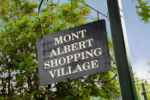Beginnings
This is an overview of the origins of the first settlements
in the Whitehorse district, which were concentrated around the present-day Box Hill area.
NUNAWADING PARISH
Nunawading is a residential suburb 18 km. east of
Melbourne between Box Hill and Ringwood. Nunawading was first the name of a parish bounded on the north by the Koonung Creek,
on the east by the Dandenong Creek and Ringwood, on the south by Highbury Road and on the west by Boundary (Warrigal) Road,
adjoining Camberwell. The parish contained the areas now known as Box Hill, Blackburn, Forest Hill, Mitcham, Vermont and part
of Burwood/Burwood East.
The Nunawading name was liberally used around the parish for various schools. In 1856 a
school was opened in the Ballyshannassay village in the south-west of the parish and called Nunawading for nine years. Its
later name was Burwood. In 1861 a school was opened on the border of Nunawading and Mulgrave parishes, to serve both areas.
It was called Nunawading for 38 years before becoming Burwood East.
Three other short-lived schools (1858-94), in the
Box Hill area were named Nunawading. The name is thought to be derived from an Aboriginal word numphawading, meaning a ceremonial
ground or battlefield.
The Shire of Nunawading, created on 4 May, 1872, comprised
the parish. On 26 May, 1925, the shire was divided into two, the Blackburn and Mitcham shire in the east and the remainder
renamed the Box Hill borough on 23 December, 1925.
Nunawading as a municipal name fell from view for twenty years until
the Blackburn and Mitcham shire was proclaimed the City of Nunawading on 12 April, 1945. Neither had Nunawading been a township
name. The area now known as Nunawading was Tunstall, and remained so until 1945.
Tunstall
township was at the intersection of Springvale and Whitehorse Roads. The clearing of the land for firewood and agriculture
pursuits had revealed deposits of clay. In the 1870s bricks and clay products were being produced, which had better access
to markets when the Tunstall station was opened in 1886, four years after the railway line was extended from Camberwell to
Lilydale.
The name Tunstall derives from this activity, as Tunstall, England, was famed for its potteries. Clay products
and orchards co-existed into the early twentieth century.
1830s
Arundel Wrighte took up a pastoral lease of 315 acres on land
which he had previously explored in the Bushy Creek area East of Elgar Rd. He erected his house on Bushy Creek near what
is now Shannon Street Box Hill North (East of Station Street and towards Goulburn Street).
1841 Henry Elgar purchased 5120 Acres of land, for one pound per acre under regulations of the Land
and Emigration Commission in London. The land was known as Elgar’s Survey and was bounded by Burke, Canterbury, Elgar
Roads and Koonung Creek.
1840s
There was increased demands for timber, wooded slopes were stripped by timber
cutters of fhe original woodland and cleared of red gum, casarina, banksia ,wattle.
George
and William Bennett occupy land on the East bank of Gardiners Creek, South of Burwood Hwy.
Thomas Toogood took up a Pastoral lease on Koonung Creek.
1854
The Ellingworth
family arrived in Box Hill and settled at the SE corner of Whitehorse Road and Station Street, Box Hill.
1860
Naming of a suburb - in
1860, Box Hill received its name at a public meeting Silas Padgham’s nomination
was selected. He was born at Dorking, at the foot of Box Hill, Surrey, England

